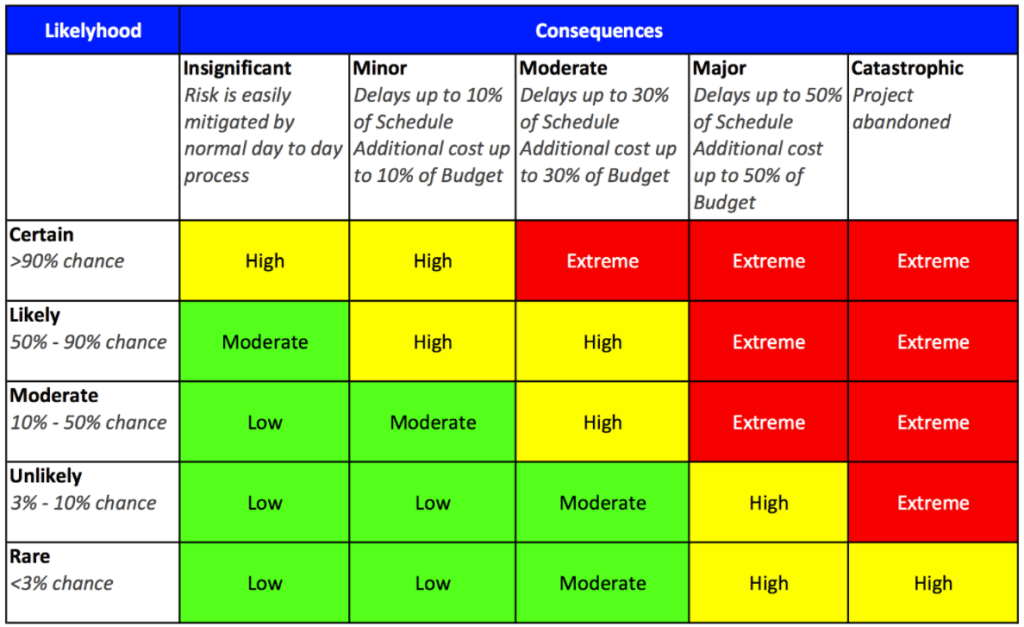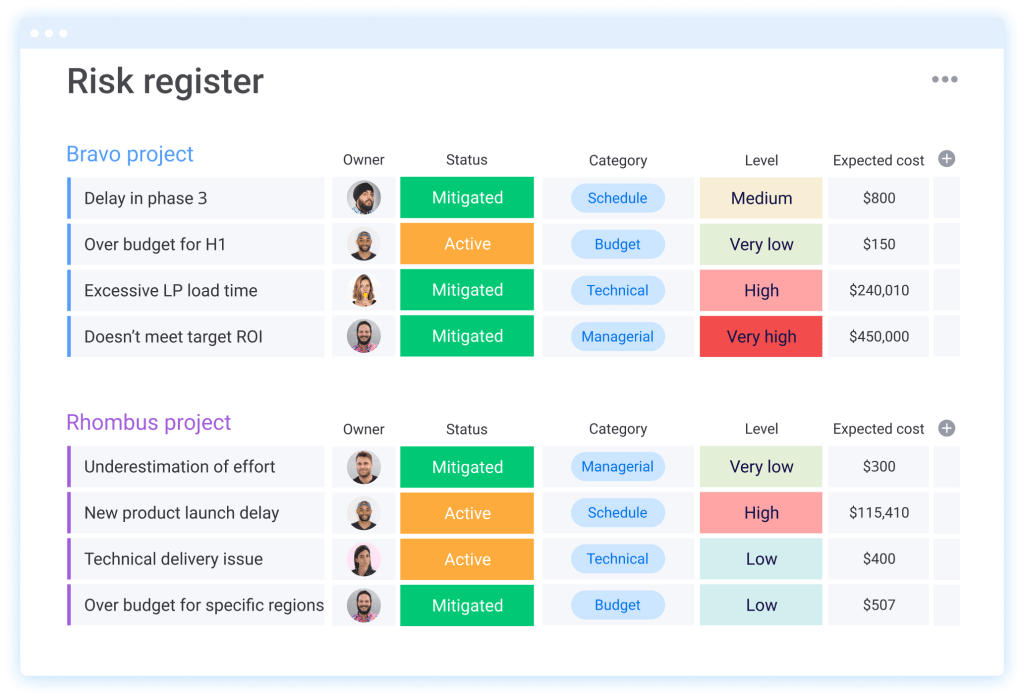Risks are inherent in any business or project activity, and good project risk management helps you approach each step with an eye toward what might go wrong so you can keep things on track. Understanding what can affect your project before you start it — and maintaining that knowledge throughout project work — lets you take a proactive approach to keep things moving forward the right way.
After reading this article, you’ll have a better understanding of what risk analysis in project management is and how you do it. We’ll also introduce monday.com, a powerful Work OS that helps you manage projects and all the risks associated with them.
What is risk analysis in project management?
Risk analysis refers to the act of risk assessment that must happen before and during a project. Project teams gather data, identifying potential risks associated with project efforts, which can include factors that might have an undesired impact on the project as well as ways the project itself might have undesired outcomes.
A proactive approach to identified risks can help project managers and team members better manage risk and increase the likelihood of success of the overall project.
Some elements of risk analysis in projects include:
- Identifying risk categories and specific risks: To understand which risks might affect your project, you might look at past experiences and data. Teams may also brainstorm potential risks as they talk about the desired workflows or what efforts the project might entail. Common categories for risk include technical or resource requirements, reliance on external resources or customers, project dependencies, budgets, and schedules.
- Defining the probability of risk occurrence: Some risks are more likely than others. It’s a good idea to assign each potential risk a probability as a percent. For example, if it’s unlikely a certain type of risk event might occur, you can assign a percentage between 1 and 30% while you would assign a risk that’s highly likely a percentage between 80 and 100%.
- Understanding the impact risks might have: Not all risk events impact projects to the same degree. Having a key member of a project team — the only one who knows how to perform a certain task — is much more impactful than someone getting sick for a few days, for example. Rank risks as low/marginal (10), medium/critical (50), or high/catastrophic (100).
By multiplying the numeric value you assigned for the probability of occurrence by the impact number you assigned, you can create a risk matrix that lets you know which risks pose the most threat to your project. Those details inform your project plans and risk management process.

Analyzing risk with help from actual statistics and data is helpful, but it’s not always possible. Learn how you can analyze risk quantitatively as well as qualitatively below.
What’s the difference between risk analysis, risk management, and risk identification?
Although they sound similar, these words mean different things and shouldn’t be used interchangeably.
Risk identification is a process that lists every potential project risk and its corresponding characteristics. As you collect your findings, you typically track them in a risk register for centralized storage and analysis. The bulk of risk identification happens at the beginning of the project, but it’s an iterative process that continues through the entire project’s life cycle.
Risk analysis is a process that determines the likelihood a risk will arise in the project. With it, you study uncertainty and how potential risks impact the project’s schedule, costs, and quality. Risk analysis is more like an art form than an exact science. Experience plays a big factor in getting it right.
Risk management uses the findings identified and analyzed to minimize, mitigate, or prevent potential risk. It essentially takes it from planning to action. As you can see, the 3 risk areas combine together to create a logical flow of risk mitigation. You identify the risks, analyze your findings, and manage them. As potential risks present themselves, you go through the flow again to make sure you’re as prepared as possible.
Get startedMethods of risk analysis
1. Quantitative risk analysis
A detailed quantitative risk analysis numerically analyzes the effects of identifiable risks on the project’s objectives. Essentially it assigns numbers — such as a 2-week delay or a $10,000 cost — to risks to help you evaluate them without bias.
Ultimately, the benefit of quantitative risk analysis is to support decision making and control risks, which will also reduce project uncertainty.
A quantitative risk analysis will determine all the possible outcomes for a project should the potential risk occur.
From there, it will figure out the probability that the project will meet its outcomes despite the risk occurrence. The analysis helps ensure the project’s schedule, scope, and costs are realistic.
2. Qualitative risk analysis
Quantitative risk assessments are always preferred but aren’t always practical or completely possible.
On the other hand, qualitative risk assessments are always possible and typically take considerably less time and resources than a standard quantitative analysis.
A qualitative risk analysis provides more general estimates of the probability of risks alongside their potential impact — such as a high probability of a severe impact.
Doing so helps:
- Reduces the level of uncertainty
- Focuses on high-priority risks
- Helps plan risk responses
How to create a risk matrix
You’ve actually been reading about a great risk analysis method throughout the first part of this article. It’s known as the risk matrix or probability/consequence matrix.
To create this matrix, create a numerical scale for likelihood and consequence. For example, you might go with a scale of one to five with one being the least likely/least impact and five being the most likely/most impact. Create a grid where the numbers for consequence are the vertical axis and the numbers for likelihood are the horizontal axis.
| Very rare (1) | Not likely (2) | Possible (3) | Very likely (4) | Almost definite (5) | |
| Negligible or no impact (1) | 1 | 2 | 3 | 4 | 5 |
| Minor impact (2) | 2 | 4 | 6 | 8 | 10 |
| Moderate impact (3) | 3 | 6 | 9 | 12 | 15 |
| Major impact (4) | 4 | 8 | 12 | 16 | 20 |
| Catastrophic impact (5) | 5 | 10 | 15 | 20 | 25 |
Consider the total risk score for each risk you brainstorm by multiplying the consequence rating by the likelihood rating. Record the scores on a separate table or risk register where you list all possible risks. Sort the risks by the final score to see which ones are more extreme than others.
Read also: How to create a risk breakdown structure
Using a bow-tie analysis
Teams looking for a way to understand specific risks might want to use the bow-tie analysis method. This analysis starts with a specific risk and teams create a brainstorming document that’s split into two sides or categories. The first lists all the potential factors that might contribute to the risk. The second lists potential solutions for each of the potential causes.
A bow-tie analysis is a great follow-up tool after conducting a risk matrix exercise. Project teams can use the bow-tie analysis to come up with potential solutions to avoid extreme risks for their projects.
As you can see, risk analysis is often a collaborative process. Plus, once you identify risks and ways to solve for them, it’s important to have tools that allow teams to work together toward those results. monday.com offers everything you need to analyze and solve for risks together.
How monday.com helps with risk analysis
Analysing and managing risk are rapidly becoming some of the more challenging aspects of managing projects. While we can’t predict the future, we can make it more predictable with the proper processes.
One way to keep all your risk in focus is by storing it all in a digital workspace like monday.com. For instance, with our risk register template:

We’re experts in tackling risk but where we really shine is project management. Here are a few more must-have features you can expect:
- Our stunning dashboards are highly customizable with dozens of custom column types, so you can tailor-make your risk process to fit your organization’s unique needs.
- Onboarding is effortless thanks to our streamlined user-interface and straightforward drag-and-drop navigation features.
- Transparency is our highest priority, and tagging, in-app messaging, and real-time dashboard guarantee everyone’s always on the same page.
- 8 unique data visualizations, including the option for Gantt charts and Kanban boards so you can visualize your data in a manner that fits your project best.
FAQ
What are the three steps of risk analysis?
The three steps of risk analysis are:
Risk identification: Teams work to identify potential risks that might impact the project
Risk analysis: Teams use tools like risk matrices to understand the impact and likelihood of risks
Risk evaluation: Teams determine which risks pose the greatest threats and work to solve for them
What is a risk analysis example?
An example of risk analysis is when a software team works to develop a consumer-facing app that requires people to log in for full features. The team might identify a risk that consumer login and other information could be at risk if there's ever a data breach. The team would then work to identify all potential causes for such a risk and implement proactive solutions to avoid or mitigate the risk.
Use a proactive approach for projects and risk management
Staying well-informed and working together seamlessly as a team are some of the best things you can do for project success. The same can be said for risk management — the team that works well in real-time to analyze and solve for risks is generally more likely to succeed.
monday.com’s collaborative communication and workflow features support project teams in doing just that. Keep everyone on the same page, ensure teams have anytime access to important data, and support seamless workflows with customized boards and other tools on our Work OS.

